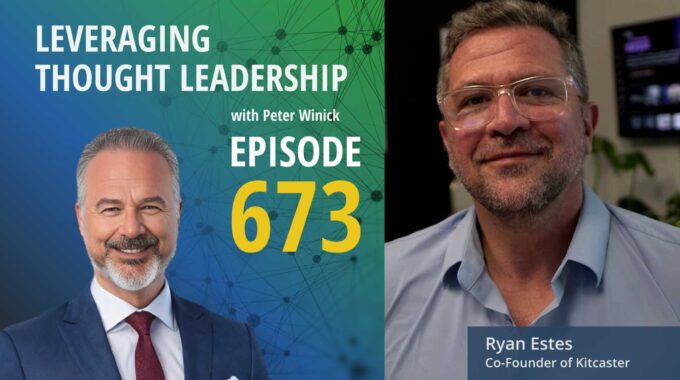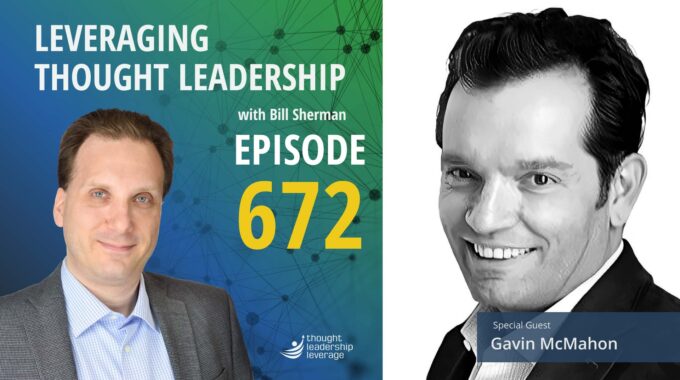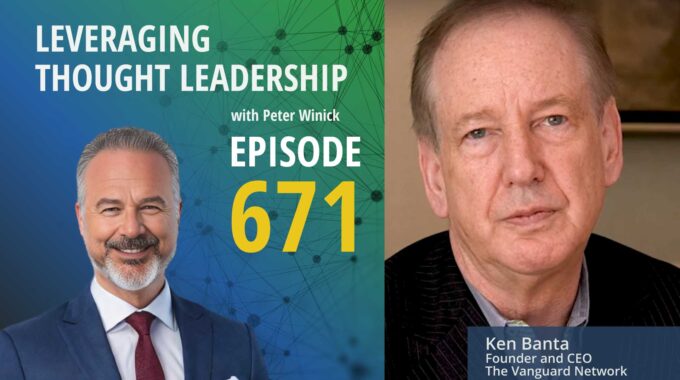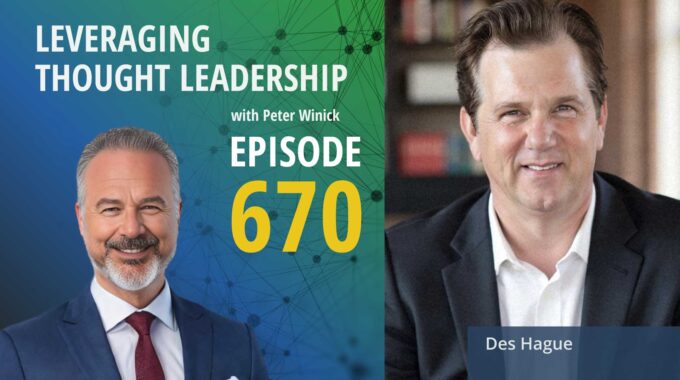Founder-led marketing, podcast strategy, and the art of authentic conversation What makes a podcast truly…
Organizational Thought Leadership Best of 2020 | Surya Kolluri, Nora Super, Luke Collins
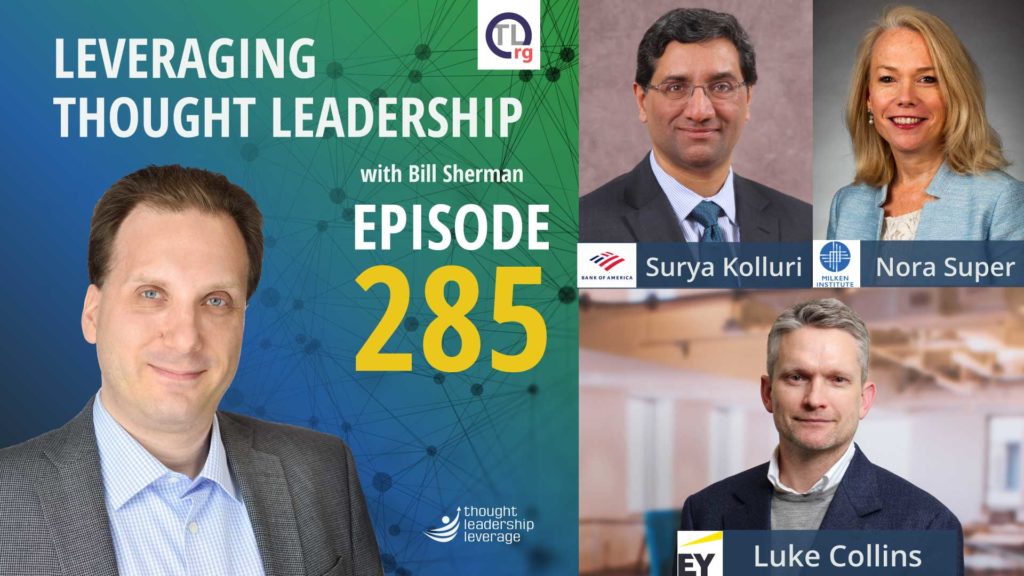
A look back at a few of our favorite organizational thought leadership guests of 2020.
Enjoy a few clips from Surya Kolluri, Nora Super, and Luke Collins!
We continue to look back at 2020 this time with a focus on some of our favorite guests from our Organizational Thought Leadership series.
We kick things off with Surya Kolluri, the managing director at Bank of America. Surya leads the thought leadership efforts for retirement and personal wealth business services. He shares how they are helping people lead better richer financial lives by training advisors on the financial challenges that various life stages present.
Next, Nora Super joins us. Nora is the Executive Director at Milken Institute, and the Executive Director of the Alliance to Improve Dementia Care at the Milken Institute. Nora discusses how convening authority helps thought leadership. She explains why bringing people from different areas and industries together to tackle a problem can have a huge impact.
Finally, we wrap up with Luke Collins, the Managing Director, and Global Editor-in-Chief at EY. Luke discusses how EY is changing the modalities in which they deliver content. He talks about how they are reaching their customers in a method that will ensure a connection. Then, he adds how the first twenty seconds of your content is the most important.
Join the Organizational Thought Leadership Newsletter to learn more about expanding thought leadership within your organization! This monthly newsletter is full of practical information, advice, and ideas to help you reach your organization’s thought leadership goals.
And if you need help scaling organizational thought leadership, contact Thought Leadership Leverage!
Transcript
Bill Sherman Hello and welcome to Leveraging Thought Leadership. I’m your host, Bill Sherman. And today we talk about one of my passions organizational thought leadership. That is the people who create, curate and deploy thought leadership on the behalf of their organization. My guest today is Surya Kolluri, the managing director at Bank of America. He leads thought leadership efforts for the retirement and personal wealth business services. He comes to thought leadership with a deep strategy. Background 14 years as a strategy management consultant at Bain and at Carney, then at Bank of America. He was head of strategy and also ran a business unit. Welcome, Syria.
Surya Kolluri Bill, thank you very much. Terrific opportunity. And I’m looking forward to our conversation.
Bill Sherman So we’re often focused on the pipeline for sales for the month or the quarter. And different business units have different time horizons, right? And so marketing sales are the most short term often. And then, like you said, strategy of 3 to 5 years and you’re even further out looking and asking that question. But I know you play an interesting role within Bank of America in terms of working with front line sales and marketing. So how do you use some of the work from looking around the corner in the future to inform what’s going on today?
Surya Kolluri Yeah, Bill, that’s a great question. And let me give you a tangible example.
Bill Sherman Please.
Surya Kolluri One of the focus areas that we have and Bank of America is to help clients leave, which are better financial lives. We are a bank and we would think about it that way. And we’ve identified life stages that we go through and looked at financial opportunities and challenges people have as they go through the stages. So you can imagine if we are focused on this aging megatrend, then if you could break that aging that your life into life stages, people can think about now how to navigate this. So that’s an example of how what’s a megatrend that, you know, you have a long horizon on is broken down into how our advisors and our product development colleagues could think about helping along those lines.
Bill Sherman So can you give an example of how those life cycles come to be and what sort of impact are they creating?
Surya Kolluri Yeah. So think about it this way. One of the big topics that folks are to think about is, for example, the topic of caregiving. So particularly in today’s day and age, when we are all isolated, you can imagine elders in the family are even more so isolated with family members not being able to visit them and help them. So caregiving is a high priority. And so a lot of our research is focused on how can we help our advisors, help our clients provide information and resources such that caregiving can be properly done. Not only are we doing that for our clients, but the bank is also doing it for our own associates. So caregiving. So you would not imagine caregiving suddenly being a topic of importance within the financial services organization. But here it is, thanks to our ability to think about what are the needs clients have. And one of the big caregiving.
Bill Sherman So let me push this a little bit further. So if I’m a financial advisor, I may be used to saying, okay, here’s a topic. I’ve got a meeting with a client coming up. I look in a set of file folders and I pull something, whether it’s a one pager on a topic or a document that just helps me prepare for that conversation. But that material could be content marketing in some ways, right? How do you help the financial advisor elevate the conversation and really create a meaningful experience between the financial advisor and the client? Can you give me an example of that?
Surya Kolluri Yeah. Well, one of the things we have done is created training for advisors on the topic of gerontology. So imagine that, that, you know, you’re not a pharmaceutical or a health care oriented organization. We’re a financial services organization. Yet, in partnership with the University of Southern California, Leonard Davis School of Gerontology have created a gerontology certificate. That advisers could take and go to eight modules, you know, take some tests and come back out of it with a certificate, which gives them a lot of confidence to have a very different conversation with clients.
Bill Sherman So give me an example of how the fall leadership team supports financial advisors. Right. What can you do that downloading, say, a content marketing piece can’t do, for example.
Surya Kolluri So it’s a terrific question, Bill. And so I’ll give you an example. In addition to the training, we also do events for clients with advisers. So I remember an occasion in the Midwest where we did an event on the topic of cognitive decline and Alzheimer’s, which is a rather specific topic. And we did that in partnership. We have a financial gerontologist on my team. So we had the interactions and just myself and a corporation that is very involved in this Alzheimer’s area. And so together we did a panel and the advisor had their practice and their clients and their families attend this event. And you can imagine the topic of Alzheimer’s being discussed with a Bank of America Merrill Lynch brand. And at the end of it, we got a lot of feedback from clients who said, Hey, thank you for putting this topic on the table that we were reluctant to discuss with the family. But now that the topic is on the table and we can discuss much more openly how we structure the communication and finances within the family to attend to this issue. So that’s a specific example of how and many of the topics you take to clients include things like, like I said before, caregiving or Social Security and other topics.
Bill Sherman I think that’s a great example. And that emotional connection that the leadership can create where you can be relevant on a much deeper level and create, in some cases, deep loyalty, where you created the opportunity for a family to have the conversation that they were struggling to have on their own right. And opening that door.
Surya Kolluri Indeed. So one of the late stages I was talking about life stages before and what are the life stages is around widowhood. You can imagine if you’re talking about emotion and complexity, that is really emotional in a complex situation. And I was not sure how that study would be received. But I can tell you once we launched it and the feedback we received is, to your point, very emotionally resonant, which opens the door to have broader, deeper conversations and build a relationship with the client.
Bill Sherman It moves from transactional to relational in a true and meaningful way When you’re standing behind someone at a truly difficult point in their life. Right.
Surya Kolluri Exactly. Exactly. And to our delight journey, there are such life events. Birth of a child, purchase of a home, retirement. Right. And each of those points, you should be able to make an emotional connection.
Bill Sherman With the more.
Bill Sherman Recently, I’ve been reflecting on the concept of convening authority. Thought leadership can raise a concepts visibility, attract people to join a conversation and spur them to take action together to tackle a big challenge. So I’ve asked Nora Super to join us for this discussion on convening Authority because it’s a topic she understands deeply. Nora has served in a variety of leadership roles, both in the public and private sector. In 2014, she was appointed by the president as the executive director of the White House Conference on Aging. Currently, Nora is the senior director of the Milken Institute Center for the Future of Aging and the executive director of the Milken Institute Alliance to Improve Dementia Care. She oversees data driven research, meaningful policy initiatives and impactful convenings both in the United States as well as internationally. The alliance is relatively new, launched only a few months ago in the summer of 2020. And so I’m looking forward to hearing the story of how she encouraged people and organizations to say we’re in to improve dementia care. Let’s begin. Welcome to the show, Nora.
Nora Super Well, thank you for having me. It’s a pleasure.
Bill Sherman You’ve used a phrase which I think is very powerful that I want to explore today, which is the concept of convening authority. There are big questions and big issues that are out in the world that no one individual or one organization can tackle, and it’s worthy of time or attention, but they often slip through the cracks. And I’d like to focus there for a moment. Let’s talk about the work that you’ve done from convening authority both with the White House and now with the Milken Institute. How does convening authority help thought leadership, and what do you need to make convening authority happen?
Nora Super Well, that’s a great question, Bill, and something that, you know, I really think about a lot through early stages in my career when I worked at George Washington University. And we bring people from government to come up with ways to move forward to. I was also a lobbyist today, IRP, during health reform, and really saw the need to get the right people in the room in order to make action happen. And as you mentioned, I have the privilege and honor of serving as executive director of the White House Conference on Aging under President Obama. When you’re in a White House, it’s a totally different sizzle factor, right? If you call someone and say, we want you to be and make a presentation and the president of United States will be there, will people listen and pay attention? And one of the things President Obama did that was very effective is if we gave folks an audience at the White House and, for example, corporate CEOs or researchers or advocates, we said, you know, what are you going to commit to do? What are you going to try to say that will be a change that you can make? And so it was really challenging the folks that wanted to present information to us to also make a commitment themselves. And I saw that as a really powerful way to get people to think about, well, what could I do? I’m not going to just go asking for something, but there are things that I can do. And we had we had culminated at the White House Conference on Aging about with almost 80 new public private sector initiatives that we announced that day and just saw this powerful ability of bringing people together from all over government. The White House, of course, has the ability to convene all different parts of government. So we had people from Treasury and Department of Labor and Corporate Justice. Not that you would always think of as folks working on aging, but they really are. They’re all part of the solution as well as corporations, many of whom, you know, provide retirement security to their employees. We had several large corporations like Alaska Airlines and Clorox step up and say, hey, we’re going to automate how we enroll people in their retirement plans. We’re going to give a better matching for that. And they stepped up to the plate to really provide better retirement security to their employees. That is measurable and something we can see impact with. We did that just across so many different spectrums. So the ability of being able to convene people at that level, which of course, when you’re talking about the White House, you have people at the CEO level. But of course, all these folks have different people underneath them that work to help implement it and bring them all on board and getting excited about what we can accomplish together. And then when I joined the Milken Institute, the Milken Institute is really just known for putting together some of the world’s most influential convenings. We put on a global conference generally, that’s about 5000 people from 400 countries in L.A. Of course, this year we need to do it virtually, but we still have the power to convene from all over industry, from the finance world to health care world down to food service providers, you name it. We’ve got them there. Some of the world’s government leaders, etc.. So really bringing people into the room, being able to say, hey, this is the issue. Here’s some ideas we’ve come up with. What do you think? And it’s just amazing when you can get a group of really smart, dedicated people all together to think about a problem, how many great solutions that people can come up with. And also just the point of not the same people talking to each other. I feel like I’m based in Washington DC and there’s a bit of an echo chamber some time on some issues where people are really just preaching to the choir and to advance change. I think it’s really important to bring new people into the room that give you new ideas, new insights, but also so that you are getting better at making your arguments or seeing what works with different types of people to really spread your message further.
Bill Sherman If you are enjoying this episode of Leveraging Thought Leadership, please make sure to subscribe. If you’d like to help spread the word about the podcast. Please leave a five-star review and share it with your friends. We are available on Apple Podcasts, Spotify and all major platforms as well as at LeveragingThoughtLeadership.com.
Bill Sherman Thought leadership often requires a delicate balance. How do you tell leaders not only what they want to know, but also what they need to know? To explore that question with me today. I invited Lou Collins. Luke is the global editor in chief and managing director at. Why he’s responsible for global thought leadership and why. Which is a strategic role that requires a deep understanding of both issues, internal experts within the organization and the global leaders they’re trying to reach through thought leadership. Lou’s been in thought leadership roles for many years prior to joining U.S.. He served as the managing director and director of publishing at Deloitte Insights and the executive editor of McKinsey Publishing. So welcome to the show, Luke.
Luke Collins Thanks, man. Thanks for having me. I appreciate it.
Bill Sherman So I want to ask you a question about modalities and shifts possibly, and modalities. So the classic big consulting House thought leadership was the magazine, the White paper, the research report. But now we have a ton of short form modalities, whether it’s a LinkedIn posed, a tweet, etc.. How has Y responded and adapted to the consumption of content? Because reaching audiences are important and people are not reading as much long form anymore. They still do, but not as much.
Luke Collins Yeah, I mean, I think it’s a work in progress for everyone, not just us. I think the general consensus is you want people to read the right content in the right place at the right time, wherever they happen to want it and in whatever format they want it. So we are pushing hard on format innovation and not for the sake of just being different, but to try and figure out exactly if you are an individual sitting in a particular role and let’s say you’re a CFO and within the marketing funnel, so to speak, you’re at the awareness phase or the consideration phase, where happens to be how are we specifically speaking to you as an individual at that point in your thought, thought process? And are we delivering the content that is necessary to help push you to the next to the next step? And I you know, in some ways, as a journalist, you know, that that is kind of a very kind of technical, almost a little bit sort of harsh isn’t the right word, but it’s a very, you know, rigid way of approaching thought leadership because, you know, we tend to think of leisure more as. People are doing work out in the field. They’ve worked with a number of clients on a particular issue. They come back with really interesting insights around how they manage to help these organizations improve. And there you write the thought leadership and it helps people and it’s a lot less direct and precise than it might be in a in a traditional content marketing world. But that’s where I get to the point about sort of the worlds merging a little bit and finding that balance between delivering content that is still reflective of what the users are demanding, what client potential clients want, and ensuring that it balances and matches up with what our needs are as an organization. You know, I struggle sometimes personally with the idea that I don’t like trying to tell users that they should find something interesting and important because we find it interesting and important because ultimately we think we work for them. At the same time, this gets back to the what you need to know and what you want to know their needs in the immediate term or what they want an answer to today we should be responding to, but we also have a perspective around what we think they should know about and be responding to over a medium to longer term or even a short term. And they just haven’t noticed it yet. So there’s definitely that balancing act. And the format innovation is critical because I, I think for a lot of cases it’s not necessarily about inventing new content or commissioning content or creating new content. In some ways it’s just being more responsive in terms of taking your existing content and passing it out, atomizing it, whatever you want to describe it into, into just more bite sized chunks across different formats and different channels.
Bill Sherman And then if someone sees one of those snackable bites and says, that’s interesting, then you can leave breadcrumbs to point them back to the larger form for sure.
Luke Collins And I’m an I’m Seamus, I am. And I sort of say I am completely format and platform agnostic. I just want you have to be the content. Yeah, yeah, yeah. I just want people to see it. I want them to get some value out of it, irrespective of how little or how much time they spend with it. I want them to get something from it. If that results in them coming back and saying, I really want to work with you guys and I want to spend a truckload of money, that’s fantastic. If it results in them getting a useful nugget that helps them solve a particular problem or even think about something differently just in the moment, I’ll take that as well, you know. But I think you’re right. We need to be we’re driven by the market. People don’t necessarily want to sit down and read a 20 minute, 4000 word think piece when what they really want is give me three. You know, we all sort of fall into the, you know, glossy magazine approach. Give me three, three things I can use to solve this, to think about this particular issue today.
Bill Sherman Well, and there’s a there’s a tension between the listicle of the here’s three quick takeaways you can do versus a think piece. Right. And a lot of people who are deep subject matter experts want to write the long form. But there’s the challenge of how do you take those insights and packaging it in a way that the reader is actually going to consume? Because it doesn’t matter if it’s the most brilliant research report ever if nobody’s touching it.
Luke Collins Right. I agree. And you face that constant battle, particularly with senior, extremely smart, successful senior people who say, I don’t want you dumbing me down, you down.
Bill Sherman This is because they perceive it as their brand, Right. And their reputation. Yeah, Yeah.
Luke Collins We’re making your content accessible. We are. I mean, I always say I want to make you look smart. I want you to look brilliant. But as you say, there’s no point being a genius sitting in the basement and no one ever sees your work or read your work or understands what you’re saying. And I think I think that’s where some of the journalistic sensibilities come in as well. I think we’ve moved toward pretty heavily trying to eliminate the more academic style of thought leadership in favor of a more news oriented or inverted pyramid style like you might find it in newsprint. You know.
Bill Sherman John Kerry the lead.
Luke Collins Yeah. It makes, you know, work on the assumption that the three most important elements and I say facetiously, spend more time on this than the rest of the article, the title of the deck or the blurb or the text where you want to describe it and the intro, I’m like that they are that that 20s is the most critically. There is nothing more important than those 20s you lose someone at that point, you’re not going to get them back. And so front load it, front load it with what’s the news point of this. Think about it how a journalist would receive a press release and what am I going to write on this front? Load the insights and then you can you can absolutely go into chapter and verse about the history and client examples and all of the stuff that really brings it to life and adds color and depth and really shows and fully demonstrates your expertise and your and your intelligence. But if you don’t get them at the beginning, know all of that is just irrelevant.
Bill Sherman Thought leadership, especially in the current environment over the last few years and I think going forward has to be punchy. You can’t write the long. Oscillatory text that goes almost in Socratic method that the big owl has at the end. Nobody’s going to get there.
Luke Collins No, and particularly not going to get there when, you know, let’s be honest, there was so much thought leadership. And it is it is it’s commoditized to the point of almost irrelevance. And so I think we are certainly focusing on, you know, editorial strategy is built around quality over quantity. You know, we really want to be more rigorous and ruthless about what we decide to publish on. And that’s not an issue of resources on our side. That’s an issue of sort of consideration for the end user. And that’s, you know, if we are if we have sort of whether it was correct or not, I’m not sure. I think in your piece a while back, talking about the percentage of time in the average executives day when they actually have the capacity to think about thought leadership or to read thought leadership, and it was minuscule. And so you begin thinking, all right, how do you grab someone who has potentially three minutes in a day? How do you grab their attention? How do you how do you cut through the noise and try and become part of the conversation for them or begin having them think differently about what your firm offers as a as a thought partners and thought leader. And yet you’re right. I mean you can’t you can’t have the you know here’s a thousand words and background on this topic and here’s 2000 words with our you know explaining the methodology behind how we did this. And here’s another thousand words and something else. And finally, at the 5000 word mark, we’ll get to something insightful. You just you can’t do that. And I’m not sure you should ever have done that. But I think you had you had the ability maybe to do that previously, but you certainly don’t anymore.
Bill Sherman If you’ve enjoyed this episode, please join our LinkedIn group Organizational Thought Leadership. It’s a professional community where thought leadership practitioners talk shop about our field. So if you’re someone who creates curates or deploys thought leadership for your organization, then please join the conversation in the organizational thought Leadership LinkedIn.


